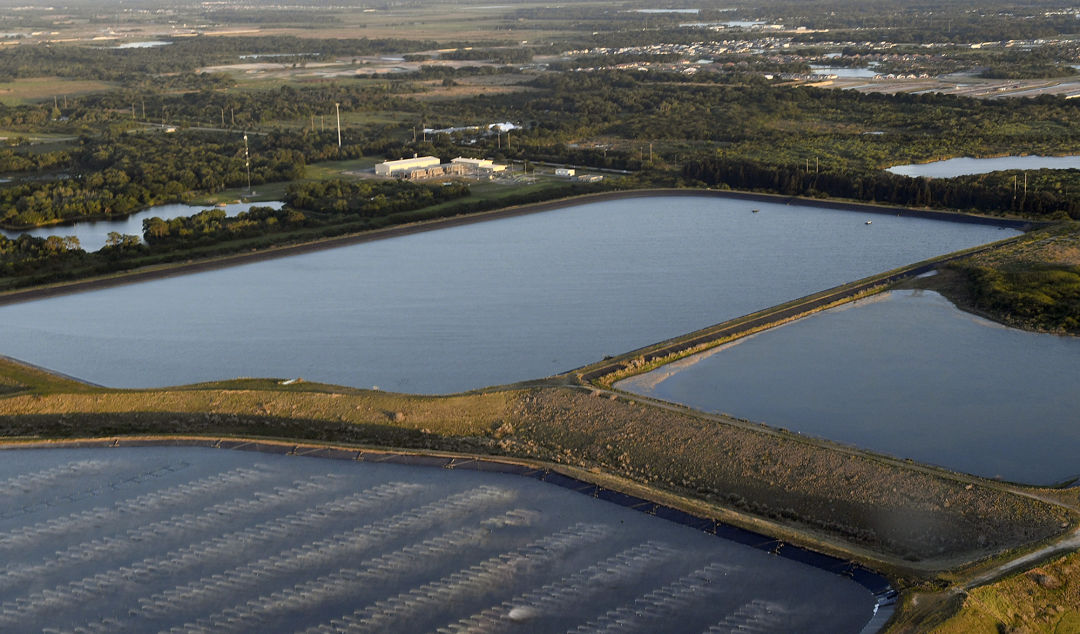How Dangerous Is the Water Leaking From Piney Point?

An aerial photo of Piney Point.
ManaSota-88 has been advocating for Southwest Florida’s environment for 53 years and has been a longtime critic of the phosphate industry. As the world watches what is happening at Piney Point, an abandoned phosphate plant in Manatee County that was built in 1966 and closed in 2001, Florida and our region face the environmental equivalent of a ticking time bomb. (For more background, read this award-winning story by journalist Craig Pittman, which details the expansion of phosphate mining in our region.)
ManaSota-88 chairman Glenn Compton talked to Sarasota Magazine about what he knows about the Piney Point leak and what’s at risk for human health and the environment.
Manatee County and the Department of Environmental Protection are saying that wastewater leaking from one of Piney Point’s stacks is not radioactive. Can we be sure?
Most information is coming from Manatee County and the Department of Environmental Protection. As far as I know, there is no third party out there that is testing the water and posting the results. According to the county and the state, the water that is being discharged does not have any radioactivity in it. I’m skeptical, because it’s leaking through a phosphogypsum stack, and the phosphygypsum stack certainly has levels of radiation that would be concerning to anybody who would get exposure from water that comes off the site. Until we have someone who goes out and verifies that there is [or is not] radiation in the water, we can’t say one way or the other that that’s accurate.
Is the wastewater still dangerous if it’s not radioactive?
The other two components that are most worrisome are the elevated levels of nitrogen and phosphorous that are currently going through the breached stack. This water never would have been permitted to have been discharged offsite because of those elevated levels. Nitrogen and phosphorous, if you put those into a water body, whether it be Tampa Bay, Bishop’s Harbor or Terra Ceia Aquatic Preserve, is adding fuel to the fire when it comes to to algal blooms. We’re expecting that from the amount of nitrogen and phosphorous that is going to be discharged—and has already been discharged—we’ll see algal blooms in the Tampa Bay area. The problem with algal blooms is it leads to fish kills.
Right now, crisis teams are pumping water out of the compromised stack to prevent a collapse. Will this solve the issue?
Certainly, you want to get the wastewater out of the existing stack, but once it's emptied, we don’t know what’s going to happen. Is this the correct way to down-draw the water out of the stack? Right now, they’re trying to avoid a catastrophic failure of one stack, but in the process, that might be setting up the failure of the other two stacks [on the site]. The question is: Once it's emptied, is that going to cause destabilization of the other two stacks? The other two stacks apparently have a lot more toxicity in the water than the one that’s currently leaking. If we have a collapse of either of those two stacks, we’re going to have a significantly different environmental impact. At this point, nobody really knows what to expect and what’s going to happen. This is unprecedented. I don’t think we’ve seen a breach of this magnitude at the Piney Point site before. To have a breach at the bottom of a stack has to be the worst possible place for this to occur and that’s the reason for the evacuations.
What about injecting this polluted water into the aquifer?
There’s been talk, even before this latest event, that deep well injection is the preferred alternative to get rid of wastewater. I have a lot of concerns about that. Once you inject wastewater into the ground, you have no idea where it’s going to go next. A lot of agricultural interests in the area that rely on well water for their crops are rightfully concerned about deep well injection. The other concern I would have about that is that if it’s done here at Piney Point, it will be the first time it’s done in Florida to get rid of wastewater from a phosphogypsum stack. We have 24 other stacks throughout the state that most likely would want to use this technology to get rid of their wastewater. To me, that would be disastrous. Once the groundwater is polluted, there’s no way to clean it up. Monitoring where the groundwater moves is an inexact science.
Is any of this going into our groundwater?
Yes. There’s no positive impact on groundwater. It’s a matter of how much goes in, how quickly it goes in and where it goes after that. If you have a toxic plume that’s moving underground and it’s between two monitoring wells, you miss it and you never fully detect that there’s a problem. If you do detect it, what do you do?
Exactly what is in a phosphogympsum stack?
Over decades, phosphate companies have dumped phosphogypsum, which is a byproduct of fertilizer production that has radioactivity in it and a number of other different chemical components that are toxic to the marine environment and any aquatic environment. They just pile it up on top of an existing area. There are over 30 tons per year being produced in the state of Florida and dumped in stacks. This [waste] can’t be used for anything. The strategy has been to stack it up over decades and to continue to go up. At the top of the stack, when it rains, water collects and ponds form. These are huge ponds. The current one [at Piney Point] is 77 acres. Most of the time there are liners under these ponds. Piney Point is just partially lined.
What do the liners do?
[When rainwater] goes through the phosphogypsum stack, it picks up the components of the stack and pollutes the groundwater underneath. The liner at the top collects rainwater, so the idea is not to allow the water to go through the stack but to collect it in a pond on top of the stack. As this rainwater collects, it needs to be disposed of so it doesn’t fill up the stack, topple it over and cause erosion of the stack itself.
Is this what happened at Piney Point?
Apparently, what has happened is that the current owners [HRK Holdings] have not been able to get rid of rainwater fast enough. The more water that goes into a stack, the heavier it becomes and the more likely it will collapse. They came to the [Manatee] County Commission a few months ago and said they were at a critical level where the stacks were filling up and they needed some help to get rid of the wastewater. So they were asking for help from taxpayers to help alleviate the problem.
Will HRK pay for any cleanup and damage?
HRK, in my opinion, will not survive this event. Companies who owned this [plant] previously have gone bankrupt. More likely, if this company walks away, the [Department of Environmental Protection] will take ownership and manage this stack and that will cost taxpayers tens of millions, if not hundreds of millions, of dollars. That’s what happened when Mulberry Corporation went bankrupt [in 2001]. Taxpayers ended up footing the bill for quite some time.
Is the state still permitting stacks?
I don’t know if there are any new stacks being considered at this point, but they’re always expanding existing stacks up and out. To my knowledge, there are no new stack locations being proposed.
Do we know if there are cancer clusters around phosphate mining sites?
That’s a difficult thing to do research on. Over the years, we’ve tried to get information from the Department of Health about cancer clusters in phosphate regions. That’s a politically hot topic. It’s difficult to find that kind of information and a hard question to answer one way or the other.
Can we prevent this from happening?
We have a lot more phosphate mining that is going to occur in the next 20 to 30 years. And there’s going to be a lot more phosphogypsum being produced. The legacy we’ve learned from Piney Point is that there is no economically feasible or environmentally sound way to manage a phosphogypsum stack. There’s a price to be paid. The price is the public’s health and the environmental impact. And, in this case, a big hit to taxpayers’ pocketbooks in trying to solve this problem.



